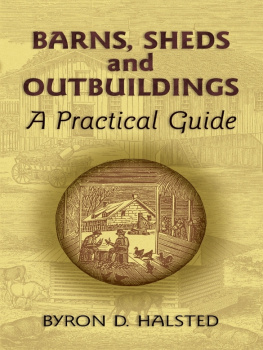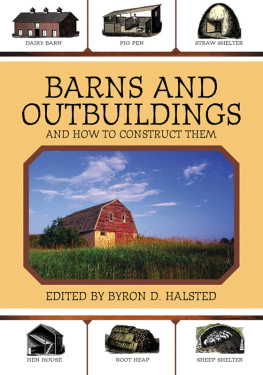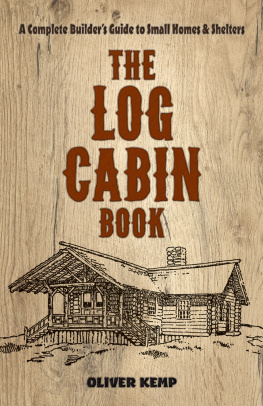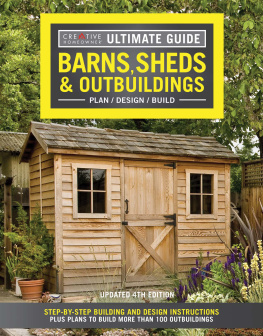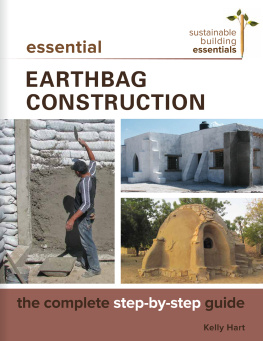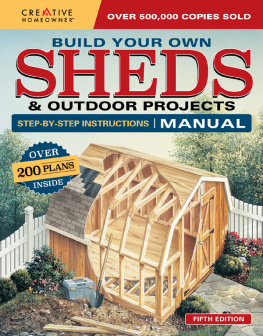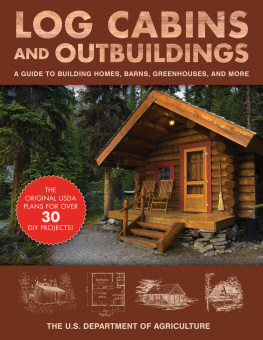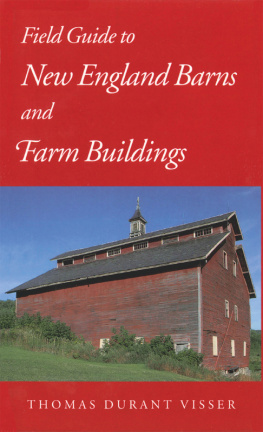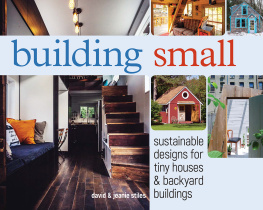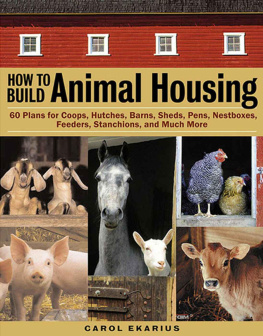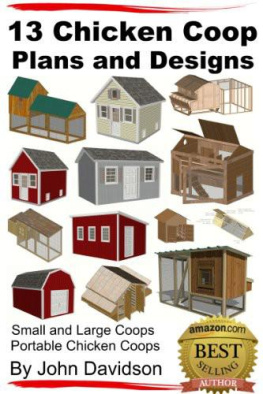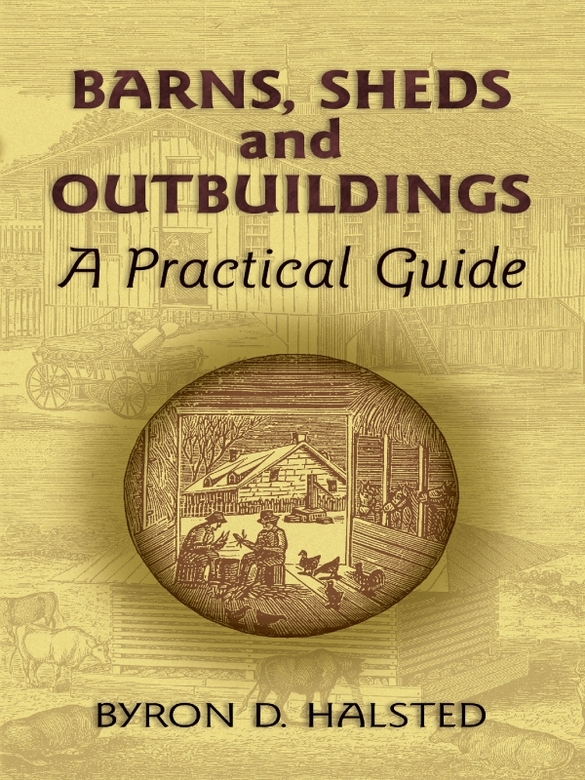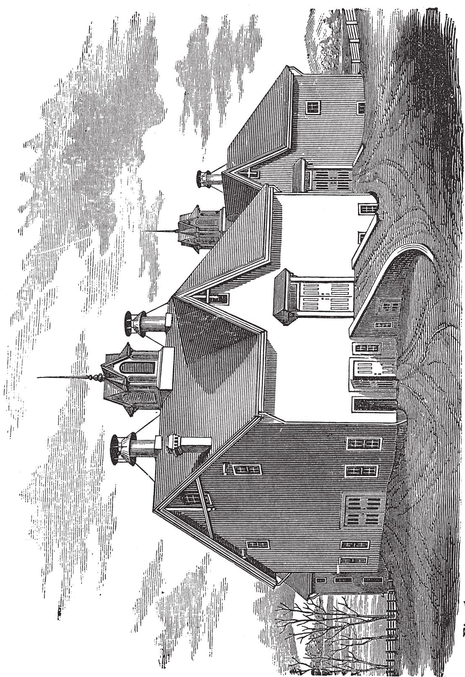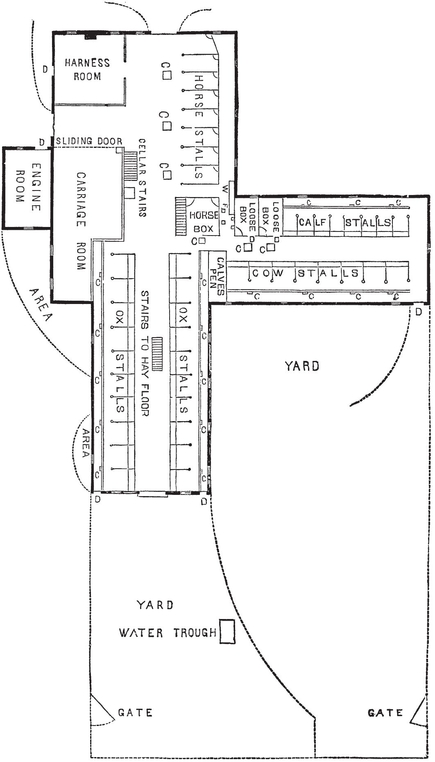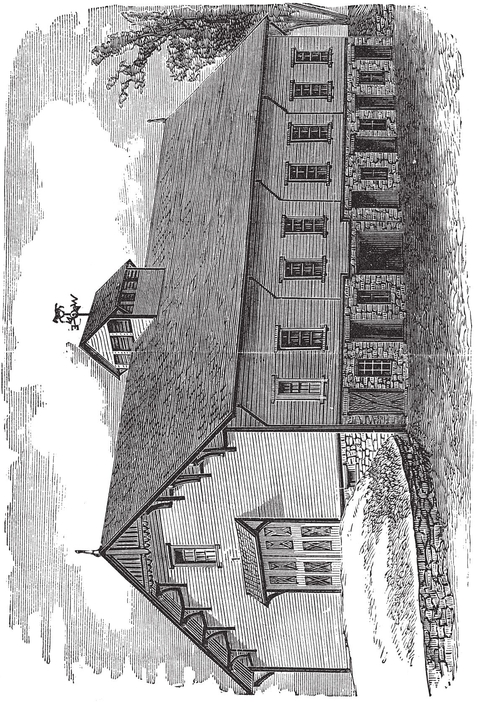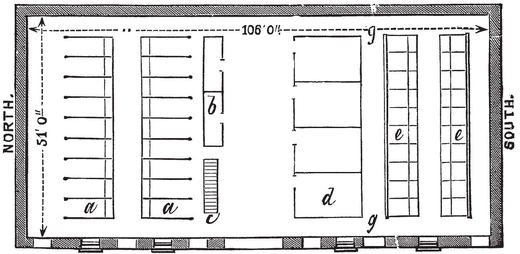CHAPTER I.
GENERAL FARM BARNS.
With the increase of wealth, and we may add of good sense and enlarged ideas, among the farmers of the country, there is a gradual but very decided improvement in farm architecture. The old custom was to build small barns, to add others on three sides of a yard, perhaps of several yards, and to construct sheds, pigpens, corn houses, and such minor structures as might seem desirable. In the course of a few years the group of roofs, big and little, span and lean-to, in the rear of a large farmers dwelling, would present the appearance of a small crowded village. Compared with a well arranged barn, a group of small buildings is inconvenient and extremely expensive to keep in good repair.
THE BARN OF MR. DAVID LYMAN.
Among the many large and expensive barns now scattered through the country, there are few more thoroughly satisfactory to old school farmers with broad ideas, than one built by the late Mr. David Lyman, of Middlefield, Connecticut. Mr. Lyman required a very large barn for his farm purposes simply, and built one, a front view and interior plans of which are here given. The elevation of the building, , shows entrances to its two main floors; there is a basement below.
THE UPPER, OR HAY FLOOR.This floor is shown in . This room is built of stone, arched above, and is roomy as well as secure.
.PERSPECTIVE ELEVATION OF MR. DAVID LYMANS BARNFROM THE NORTH WEST.
By means of a hay fork and a number of travellers, the hay is taken from the loads and dropped in any part of the immense bays. The forks are worked by one horse, attached to a hoisting machine, of which there are two, placed near the great doors during the haying season, as indicated by the letters marked H , P , in the plan, .
On the main floor are bins for grain and ground feed, provided with shutes connecting them with the feeding floor. There are hay scales, alsoa fixture in one of the floorswhich afford the means of being very accurate in many things, in regard to which guess work is ordinarily the rule. The great ventilators, so conspicuous in , pass from the feeding floor to the roof, and are furnished with doors at different elevations, quite to the top of the mow, thus forming convenient shutes to throw down hay or straw. A long flight of stairs passes from the principal barn floor to the cupola, from which a magnificent view is obtained of the whole farm and surrounding country.
THE FEEDING FLOOR is entered by several doors. Two double doors open upon a spacious floor in the rear of the horse stalls, which extends through the middle of the main barn. The northwest corner, , indicates a trap door of a manure drop. The letter D is placed wherever there are doors which, in the engraving, might be taken for windows.
The cattle pass to the yards through doors in the ends of the wings. The south yard is nearly upon a level with the floor, sloping gradually away toward the south and east; but the large barn yard is on the level of the manure cellar, and an inclined way gives access to the yard on the east side, from the cow stalls. Three roomy, loose boxes are provided, one for horses, and two as lying-in stables for cows. Near the points marked W , and F , stands the hydrant for flowing water, and the trough for mixing feed, and here, too, the shutes for grain and cut feed discharge from the floor above.
VENTILATION AND LIGHT.Four immense ventilating trunks, four feet square, rise from the feeding floor straight to the roof. These are capped by good ventilators of the largest size, and cause a constant change of air in the stables, the draft being ordinarily sufficient to be felt like a fresh breeze, by holding the hand anywhere within a few feet of the openings. This keeps the air in the whole establishment sweeter and purer than in most dwellings. The windows on all sides of this floor are of large size, with double sashes, hung with weights.
THE BARN CELLAR.This is arranged for hogs, roots, and manure. The fixed partitions in the cellar are only two, one enclosing the root cellar, and the other, outside of that, shutting off a wide, cemented passage way, extending from the door at the northeast corner, around two sides of the root cellar, as shown in . The rest of the cellar is occupied by the manure, and hogs are enclosed in different parts of the cellar, according to convenience.
SIZE OF BARN.The building covers more than one-fifth of an acre of land, and thus there is over three-fifths of an acre under a roof. The main barn is fifty-five by eighty feet. The wings are each fifty-six feet long, the south one being thirty-five wide, and the east wing thirty-one and one-half feet wide. The four leading points sought for and obtained were: first, economy of room under a given roof, second, plenty of light, third, plenty of air, and ventilation which would draw off all deleterious gas as fast as generated, and fourth, convenience to save labor. Saving of manure, and many other things were of course included. The windows are all hung with pulleys, and are lowered in warm days in winter, and closed in cold days. This is important.
MR. LAWSON VALENTINES BARN.
The perspective view and plans here given, represent the fine barn on Houghton Farm, the property of Mr. Lawson Valentine, Mountainville, Orange County, N. Y. It is located on a hillside, and is supplied with water brought from springs. The barn is handsomely proportioned, and with its slated roof and red-painted walls, with black trimmings, presents a fine appearance. It is admirably adapted for keeping a large number of horses, and a good model for any well-to-do farmer desiring a handsome and useful barn. In its general plan it may be followed on a smaller scale by any one having horses and cattle for which to provide stabling and shelter.
.MR. LAWSON VALENTINES BARN, HOUGHTON FARM, MOUNTAINVILLE, N. Y.
The building is one hundred and ten feet long, by fifty-five feet wide, with twenty-foot posts, and is forty feet from the main floor to the ridge. It rests on a stone basement ten feet high in the clear; this basement provides comfortable and convenient stabling for the owners fine stud. The division is shown at represents one of the horse stalls. The upper portion consists of iron rods ex-tending from the top of the sides to a railing two feet above. The front is provided with screen doors.

